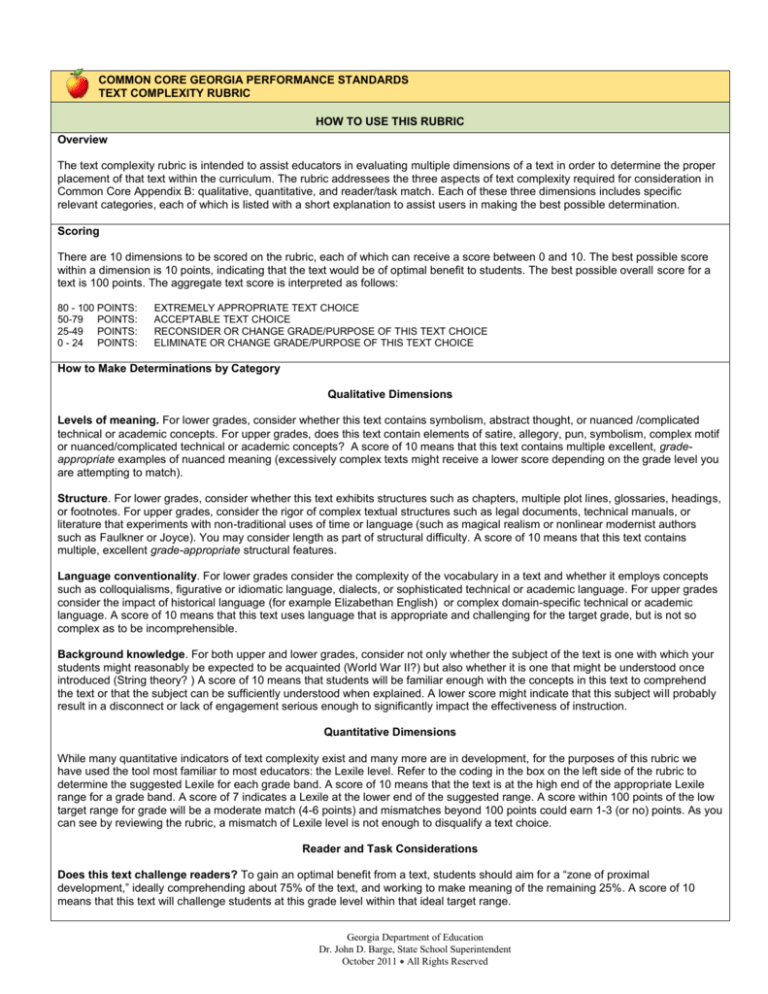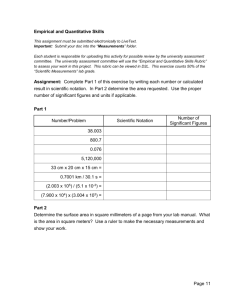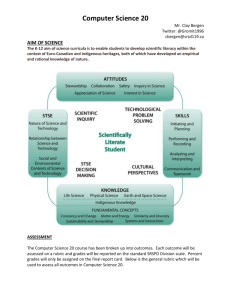
COMMON CORE GEORGIA PERFORMANCE STANDARDS
TEXT COMPLEXITY RUBRIC
HOW TO USE THIS RUBRIC
Overview
The text complexity rubric is intended to assist educators in evaluating multiple dimensions of a text in order to determine the proper
placement of that text within the curriculum. The rubric addressees the three aspects of text complexity required for consideration in
Common Core Appendix B: qualitative, quantitative, and reader/task match. Each of these three dimensions includes specific
relevant categories, each of which is listed with a short explanation to assist users in making the best possible determination.
Scoring
There are 10 dimensions to be scored on the rubric, each of which can receive a score between 0 and 10. The best possible score
within a dimension is 10 points, indicating that the text would be of optimal benefit to students. The best possible overall score for a
text is 100 points. The aggregate text score is interpreted as follows:
80 - 100 POINTS:
50-79 POINTS:
25-49 POINTS:
0 - 24 POINTS:
EXTREMELY APPROPRIATE TEXT CHOICE
ACCEPTABLE TEXT CHOICE
RECONSIDER OR CHANGE GRADE/PURPOSE OF THIS TEXT CHOICE
ELIMINATE OR CHANGE GRADE/PURPOSE OF THIS TEXT CHOICE
How to Make Determinations by Category
Qualitative Dimensions
Levels of meaning. For lower grades, consider whether this text contains symbolism, abstract thought, or nuanced /complicated
technical or academic concepts. For upper grades, does this text contain elements of satire, allegory, pun, symbolism, complex motif
or nuanced/complicated technical or academic concepts? A score of 10 means that this text contains multiple excellent, gradeappropriate examples of nuanced meaning (excessively complex texts might receive a lower score depending on the grade level you
are attempting to match).
Structure. For lower grades, consider whether this text exhibits structures such as chapters, multiple plot lines, glossaries, headings,
or footnotes. For upper grades, consider the rigor of complex textual structures such as legal documents, technical manuals, or
literature that experiments with non-traditional uses of time or language (such as magical realism or nonlinear modernist authors
such as Faulkner or Joyce). You may consider length as part of structural difficulty. A score of 10 means that this text contains
multiple, excellent grade-appropriate structural features.
Language conventionality. For lower grades consider the complexity of the vocabulary in a text and whether it employs concepts
such as colloquialisms, figurative or idiomatic language, dialects, or sophisticated technical or academic language. For upper grades
consider the impact of historical language (for example Elizabethan English) or complex domain-specific technical or academic
language. A score of 10 means that this text uses language that is appropriate and challenging for the target grade, but is not so
complex as to be incomprehensible.
Background knowledge. For both upper and lower grades, consider not only whether the subject of the text is one with which your
students might reasonably be expected to be acquainted (World War II?) but also whether it is one that might be understood once
introduced (String theory? ) A score of 10 means that students will be familiar enough with the concepts in this text to comprehend
the text or that the subject can be sufficiently understood when explained. A lower score might indicate that this subject will probably
result in a disconnect or lack of engagement serious enough to significantly impact the effectiveness of instruction.
Quantitative Dimensions
While many quantitative indicators of text complexity exist and many more are in development, for the purposes of this rubric we
have used the tool most familiar to most educators: the Lexile level. Refer to the coding in the box on the left side of the rubric to
determine the suggested Lexile for each grade band. A score of 10 means that the text is at the high end of the appropriate Lexile
range for a grade band. A score of 7 indicates a Lexile at the lower end of the suggested range. A score within 100 points of the low
target range for grade will be a moderate match (4-6 points) and mismatches beyond 100 points could earn 1-3 (or no) points. As you
can see by reviewing the rubric, a mismatch of Lexile level is not enough to disqualify a text choice.
Reader and Task Considerations
Does this text challenge readers? To gain an optimal benefit from a text, students should aim for a “zone of proximal
development,” ideally comprehending about 75% of the text, and working to make meaning of the remaining 25%. A score of 10
means that this text will challenge students at this grade level within that ideal target range.
Georgia Department of Education
Dr. John D. Barge, State School Superintendent
October 2011 All Rights Reserved
Does this text match the interests of the students? Whether or not students will find a text interesting, exciting, or engaging is not
always a primary consideration in text selection; however, even the most technical texts can be chosen to provide some avenue for
connection with students. A score of 10 means that, in so far as possible, this text is the best choice for the target age and
demographic.
Is this text ideal for the task? Genre is often the most important consideration for task matching. For example, a scientific journal
will be a better match for a research project than for a skit depicting the content. A score of 10 means that this text is the best
possible match for the task the students will be expected to perform.
Mismatches for which qualitative and quantitative measures cannot easily account. This dimension of scoring exists to provide
evaluators with a category to bestow or withhold points based on areas of disconnect that may not be addressed in other rubric
dimensions. For example, if a book is an excellent match for a grade level content focus, but low on the Lexile, the overall score may
be boosted through this category. If a book seems to be an excellent match in Lexile or structure but is too mature or disturbing for
the grade level, points may be withheld in this category.
Specific Merit
This category exists to allow evaluators to bestow additional points based on the unique merits of a text, for example, a Newberry or
Caldecott Award, or Nobel or Pulitzer Prize. Books widely considered to be classics or that are fundamental to instruction in a given
field (such as Native American mythology, the Holocaust, etc.) may receive points in this category. A score of 10 means that this text
has garnered positive acknowledgement from multiple authoritative sources.
A Note to the Evaluator
This rubric is intended to provide a framework to assist educators in making considered decisions within the parameters suggested
by the Common Core Georgia Performance Standards. As with any evaluation tool, exceptions to the rule will exist. In most cases
the dimensions of the rubric that allow for consideration of additional literary or technical merit and other elements specific to a given
text will allow for unique aspects of a text to be quantitatively evaluated. This tool is intended to streamline and create consistency
within the text consideration process, not to be a definitive measure. We hope you will find it useful!
Georgia Department of Education
Dr. John D. Barge, State School Superintendent
October 2011 All Rights Reserved
COMMON CORE GEORGIA PERFORMANCE STANDARDS
TEXT COMPLEXITY RUBRIC
TEXT:
GENRE:
GRADE:
LOW (1-3
MODERATE
HIGH (7-10
COMPLEXITY MEASURE
POINTS)
(4-6 PTS)
POINTS)
Qualitative aspects of text complexity best measured by an attentive human reader, such as levels of meaning or purpose; structure;
language conventionality and clarity; and knowledge demands.
Levels of meaning. K-5: Symbolism, abstract thought,/technical, academic
content
6-12: Satire, allegory, pun, symbolism, or complex motif/technical, academic
content
Structure. K-5: Chapters, multiple plot lines, glossaries, headings, or footnotes.
6-12: Legal documents, technical manuals, non-traditional uses of time or
language
K-12: Text length
Language conventionality. K-5: colloquialisms, figurative/ idiomatic language,
dialects, technical and academic vocabulary
6-12: Historical language such as Elizabethan or Old English constructions;
technical and academic vocabulary
Background knowledge. Content with which students might reasonably be
expected to be acquainted or that will be comprehensible when introduced
Quantitative aspects of text complexity, such as word length or frequency, sentence length, and text cohesion, that are difficult for a
human reader to evaluate efficiently, as measured by Lexile.
K-1
n/a
2-3
450L - 790L
4-5
770L - 980L
6-8
955L - 1155L
9-10
1080L - 1305L
11-12
1215L - 1355L
Reader and Task Considerations focus on the inherent complexity of text, reader motivation, knowledge, and experience and the
purpose and complexity of the task at hand. Best made by teachers employing their professional judgment.
Does this text challenge readers? Readers comprehend about 75% of the text,
working to make meaning of the remaining 25%
Does this text match the interests of the students?
(When appropriate)
Is this text ideal for the task?
For example a scientific journal for a research project versus Shakespeare for a
dramatic presentation
Mismatches for which qualitative and quantitative measures cannot easily
account.
For example low Lexile books with adult content
Miscellaneous considerations. You may award up to 10 points for specific merits of a text not covered in the rubric domains.
Specific Merits
Please write a brief explanation of the specific merits of this text in the box
beneath the points awarded
TOTAL SCORE
80 - 100 POINTS:
50-79 POINTS:
25-49 POINTS:
0 - 24 POINTS:
__________ / 100
EXTREMELY APPROPRIATE TEXT CHOICE
ACCEPTABLE TEXT CHOICE
RECONSIDER OR CHANGE GRADE/PURPOSE OF THIS TEXT CHOICE
ELIMINATE OR CHANGE GRADE/PURPOSE OF THIS TEXT CHOICE
EVALUATOR COMMENTS:
Georgia Department of Education
Dr. John D. Barge, State School Superintendent
October 2011 All Rights Reserved







